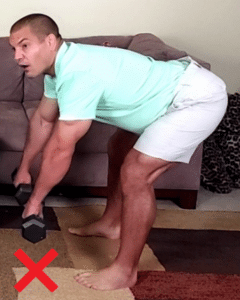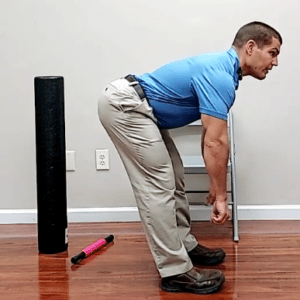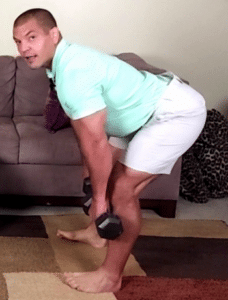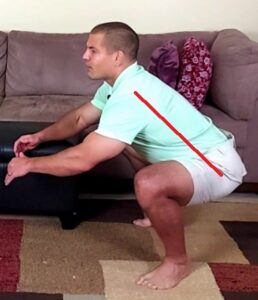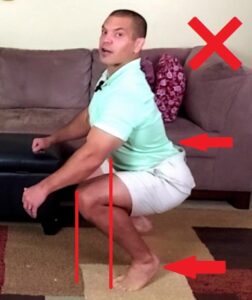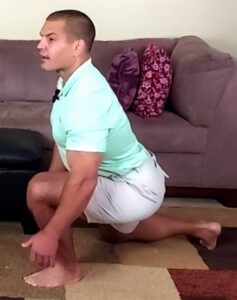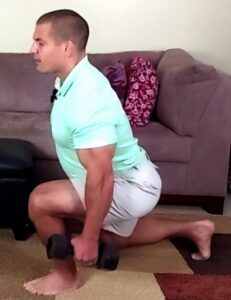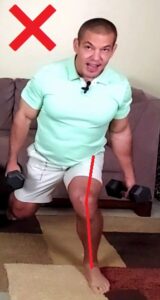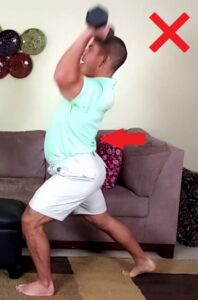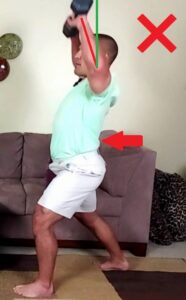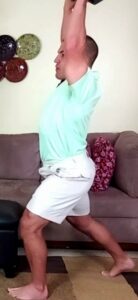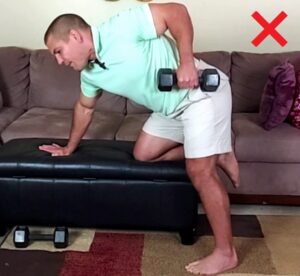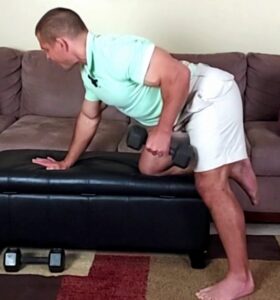Maintaining strength and mobility are some of the biggest concerns that I hear about from seniors. However, when you dig a little deeper, what it really boils down to is maintaining function and quality of life. Watch this video to learn 7 senior strength training exercises can help improve your daily function and quality of life.
Why Is Strength Training Important For Seniors?
Maintaining strength and mobility allows seniors to continue doing the activities that bring value to their lives.
For some people, that may mean being able to play golf or pickleball. For others, it's spending time with their grandchildren, and yet for others, it's just being able to stay independent in their own home so that they don't have to go to a nursing home.
Whatever quality of life looks like for you, chances are that if you want to maintain your strength and mobility, you're probably going to have to do some exercises.
But as a physical therapist, I know that most patients don't do their exercises.
And largely, it's not their fault.
Most physical therapy exercises don't directly benefit you in your everyday life.
And why would you invest time and effort into doing strength training exercises if you can't see how they will improve your function or quality of life?
So, in this post, you'll learn 7 senior strength training exercise that directly translate into functional benefits in your everyday life.
I'll go through each of these strength training exercises step by step and give you some specific technique pointers you can use to make sure that you're doing them in the safest, most effective way possible.
7 Senior Strength Training Exercises
The exercises that I'm going to describe in this post are referred to as primal movements.
Primal movements are functional movement patterns that humans have been doing in for thousands of years. Furthermore, we continue to do them today in our everyday lives
Largely, primal movements can be broken down into seven categories:
I'll describe each of these senior strength training exercises step-by-step below.
Bend (Hinge)
The first one is the bend. Bending is helpful to be able to pick things up off the floor.
It may be cleaning up around the house, picking up your grandchildren, or getting pots out from underneath the stove.
Everyone has to be able to bend.
Some people who have back problems have been told that they should never bend. However, bending is absolutely good and healthy for your spine if you do it correctly.
You don't want to bend by leaning forward from the waist where your center of gravity goes out in front of your hips.
Firstly, you get off balance, so you could potentially fall.
Additionally, your back muscles have to work much harder to keep you from falling forwards.
The way that you should bend is by pushing your hips backward as your head goes forward. That keeps your center of gravity balanced over top of your feet.
As you push your hips back, your weight should go onto your heels.
It's okay if your knees bend a little bit; they don't need to stay completely straight. However, but you shouldn't be doing a squat either.
That's the next senior strength training exercise that we'll get to.
Once you've bent, your prime movers for coming back up are going to be your butt muscles, your glutes, as well as your hamstrings.
This is hip extensor strengthening exercise, not a back extensor strengthening exercise.
Your abdominals and lower back muscles are co-contracting together to stabilize your spine. Largely your spine should be staying in a pretty neutral position.
Just focus on pushing your hips and pelvis backward and then squeezing your glutes to push them back forwards.
The deadlift is a perfect strength training exercise to help seniors bend and lift
If you're just having trouble with bending in your everyday life, I would suggest starting with just doing a bodyweight bend or hip hinge.
Then, if you want to add some weight, you can grab a pair of dumbbells.
Keep the dumbbells close to your body.
The closer to your center of gravity you keep the weight, the easier it is. The further away it gets, the more stress it puts on your back muscles.
So keep the weight close to your body, push your hips back, hips forward, hips back, hips forward.
So, that's the first senior strength training exercise: the bend.
Learn more about how to lift without hurting your back in this post.
Squat
The second senior strength training exercise is the squat.
If I had to pick just one exercise, I'd say the squat is the best overall strengthening exercise for seniors because it's such a functional movement pattern that we use every day. For example:
The squat is also a great senior strength training exercise because it uses several different muscle groups:
- Your quads
- Your glutes
- Your abdominals
- Your back extensors
- Your spinal stabilizers
To do the squat, you want to first get your feet set in the right position.
Make sure that you just use a natural stance; you don't want to force your toes straight ahead. Just find what feels normal to you.
Then, wherever your feet point, you want to turn your knees out so that your knees are over your toes.
If your toes point straight ahead, your knees should point straight ahead. If your feet point out a little bit, your knees should also point out a little bit.
Start your squat by doing a little bit of a hip hinge. So, it's a little like the bend, but you're going to allow your knees to bend more in this than in the hip hinge.
Push your hips back while bringing your trunk forward slightly.
You should keep your back straight, but not vertical.
You don't want to allow your heels to come off the floor or your knees to go much in front of your toes.
Doing so puts more stress on you knees, which can be problematic if you have knee arthritis.
Learn how to squat without knee pain here.
Furthermore, if you keep your back vertical, it's likely that you're going to arch your back too much. See the image above.
This can be a problem if you have degenerative disc disease or spinal stenosis.
So, you want to get your spine in a neutral position.
Push your hips back just a little bit, and then drop down with your hips going backward and your trunk going forwards.
Many seniors will have pain or difficulty doing deep squats though.
A good senior version of the squat is just doing a chair stand.
- Get your feet set.
- Turn your knees out.
- Push your hips back.
- Lower your bottom down to a chair or bench.
If you are able to get deeper than a chair, certainly go ahead and do that. But just doing a little chair stand is a good, accessible way for most seniors to strength train their legs.
As your legs get stronger, you can add weight by holding dumbbells while you squat.
Lunge
Now, the next senior strength training exercise is the lunge.
The lunge is also really important for being able to get up off the floor.
For example, you may need to get off the floor after playing with grandchildren.
Or, you may at some point need to get up from the floor after a fall. (Hopefully not.)
Going up and down stairs is also a modified version of a lunge where you're putting one foot up, then the other foot up, then the other foot up.
So, doing a lunge is a great way to help increase your glute strength and your quad strength, as well as it gives you some side-to-side balance as well.
A squat is a pretty symmetrical exercise where you're balanced side to side, but with a lunge, you have to get a little bit more side-to-side stability.
How to do lunges
To do a lunge, you want to start with your feet staggered. Most of your weight should be through your front foot.
Hold on to something for balance if needed.
Your back foot on the ground for balance, but the front leg is going to be doing most of the work.
You don't want to bring your knee forwards as you're lunging.
Think about sitting your bottom back with your weight on the front heel.
If you're just starting out doing lunges, you may not go all the way down to the ground.
Just pick a depth that feels easy for you and start out there.
Start out doing a partial lunge. Then as you get stronger over time, you can make this exercise harder by going down deeper.
And then if you get better at that, obviously, you can still add weight.
From the front view, keep your toes, knee, and hip all in alignment. Don't let your knee drift inward.
So, that's the lunge.
Push
Next is the push, and pushing can come in two forms.
It can come in the form of a horizontal push or a vertical push.
A horizontal push is pushing a grocery cart or pushing a lawnmower, for example.
But in most everyday situations, we don't do this type of bench pressing or push-up movement a whole lot.
What we do more commonly, and what many seniors have trouble with, is lifting things up over their head - more of a vertical push.
So the strength training exercise I'm going to choose for this workout is a vertical push.
The Overhead Press
You will probably want to use some dumbbells for this exercise.
Keppi Adjustable Dumbbells Set, 25lb Pai...
$199.79 (as of July 26, 2024 11:31 GMT -05:00 - More infoProduct prices and availability are accurate as of the date/time indicated and are subject to change. Any price and availability information displayed on [relevant Amazon Site(s), as applicable] at the time of purchase will apply to the purchase of this product.)However, if you have some shoulder pain raising your arm overhead, then I'd suggest you just start with the weight of your arms.
Then add some light dumbbells as you're able.
But I'll show it with weights just so you get an idea.
Now, the first thing here, you want to make sure you do is keep a good spinal alignment.
Don't arch your back as you're doing a shoulder press.
It does help to stagger your feet in a little bit of a lunge.
So, you want to have your feet forwards and backwards. This gives you front to back stability.
You also want to have them a little bit wider; this gives you side-to-side stability.
That way, you won't tip over as you're doing an overhead press.
The higher you move the weight, your center of gravity moves upwards, which makes you a little bit more unsteady.
So, get a good base of support in sort of a staggered stance position.
Roll your pelvis underneath of you so you get your spine in a neutral position.
Then you bring the weights up.
Keep your elbows in front of your hands.
You don't want to try and push up where your elbows are behind you or behind your hands.
This is a common mistake that I see a lot of people make, not just seniors.
They try to press up with their elbows to their side.
You have no power this way. If you look at Olympic weightlifters, when they do the clean and jerk, you'll notice they kind catch the weight in a front rack position with their elbows in front.
This gives them more power.
This also helps you keep your shoulders externally rotated, which means you're not going to impinge your rotator cuff muscles.
Then think about driving your elbows up towards the ceiling.
It's not so much about thinking about pushing the weights.
Think about pushing up with your elbows towards the ceiling .
Again, that helps you put things away on high shelves or in high cabinets.
You may want to start with a very light weight on this and then progress up as you feel comfortable.
So, that's the push.
Pull
The next exercise is the pull,.
Just like the push there are horizontal pulls and vertical pulls.
Examples of a horizontal pull include a row or starting a lawnmower or pulling a box off of a shelf.
There's also a vertical pull like a pull-up or a pull-down machine at the gym.
But unless you're climbing trees or pulling yourself up on ladders, most people don't have to do a vertical pull in their everyday life.
That's because as we pull things down, gravity is helping us.
So there's not a lot of resistance in a vertical pull.
Horizontal pulls, however, we do a little bit more often, either pulling things towards us or picking things up in a bent-over row-type fashion.
And so that's the exercise that I'm going to choose:
The Single-Arm Bent Over Row
Now, jumping the gun on this, this also has a little bit of a rotational aspect.
Rotational or twisting movements can come in the form of rotational movements where you're twisting, or anti-rotation movements where you're preventing twisting.
You're stabilizing your spine and preventing your spine from twisting when it might otherwise twist.
This strengthening exercise, the one-arm bent-over row, gives you both the pulling aspect as well as an anti-rotation exercise.
Your spine is going to want to twist, and you're going to have to stabilize against it.
Hold a dumbbell in one hand.
Put your knee and opposite hand on a chairs, bench, or couch.
Your other foot should be on the floor.
Let the weight hang down and let your shoulder blade sag forwards.
What you don't want to do in this exercise is pull your elbow too high.
This causes a lot of spinal rotation. It also extends your shoulder probably more than you really want to be doing, especially if you have shoulder pain.
Think about squeezing your lat muscle to initiate the movements.
Think about bringing the shoulder blade down and up, down and up.
Pull your elbow in towards your waist.
Initiate the movement by thinking about moving your elbow, not about moving the weight.
The movement is a bit like starting a lawnmower, but you don't want to allow your trunk to twist.
You should feel this in your lat muscles and the muscles between your shoulder blades.
So, that's the pull.
Twist
Now, next is the twist.
We just did an anti-rotation exercise, so for the twist, we're going to incorporate a rotation exercise.
Now, a lot of people think about twisting crunches or bicycles for these types of exercises.
However, it's not that common that you lay on your back and do twisting abdominal-type movements in everyday life.
One thing you do a lot, though, is pivot.
Whether you're playing golf or pickleball or taking laundry from the washer to the dryer or whether you're taking dishes from the sink to the dishwasher.
We do a lot of this pivoting movement.
Most gym exercises are more in this front-to-back plane. They don't address that pivot-rotation plane very much.
So for this exercise, I'm going to show a hip swivel.
This is more a mobility exercise than a strength training exercise.
Think about a downhill skier where they kind of shift one way to the other, shifting weight inside to outside.
Your weight on your feet should be on the big toe side of one foot and little toe side of the other.
Then just shift back and forth.
If you do have some knee arthritis, start with just really little swivels. Then you can progress into bigger ranges as you feel comfortable.
So, those are the senior strength training and mobility exercises.
How Many Sets and Reps of Each Exercise?
I should address repetitions and sets because that's a question that I always get.
Largely, as long as you're challenging yourself and progressing over time, the actual number of sets and reps doesn't matter.
Start with something that's challenging for you and then progress over time.
If you are following more strict strength training rules, if you're trying to build strength, then you want to shoot for 8 to 10 reps.
And what I mean by strength is, "I can only lift 5 pounds from the ground, and I need to be able to lift 20 to be able to lift a bag of cat food."
Then, in that case, you might be shooting for that 8 to 10 range.
Note that a set of 10 repetitions means that you can do 10 reps with good form, but you CANNOT do an 11th rep without cheating.
If you could do 2 or 3 sets of 10 in a row, your weight is WAY too light.
On the other hand, if you can say, lift your 25-pound grandchild, but if you do it more than a few times a day, your back's going to pay for it. In that case, you may be training more for muscle endurance.
In that case, you're going to look more in the 15 to 20 repetition range.
Even Seniors Can Do Strength Training
It really only takes minutes a day to do this senior strength training routine once you get the exercises down.
As demonstrated in the video above, you can do 10 repetitions of each exercise in about 2.5 minutes.
That's achievable for most people.
You don't have to do just 10 reps of each.
Again, just use a weight and rep range that works for you based on your current abilities, and then progress over time.
What About Walking?
Now, you may notice that there was one functional movement that I left out of this video, and that's walking.
Walking isn't a strength training exercise, but it is important.
And the best exercise to help your walking is actually just walking. But if you're going to walk, you may as well do it right, and to learn how to do that, I'd suggest you check out this post: Try This Unique Exercise For Walking Balance, Flexibility, & Strength
St. Louis Seniors: Need Help To Improve Strength & Mobility?
Tap the button below to request an appointment with one of our specialist physical therapists.


